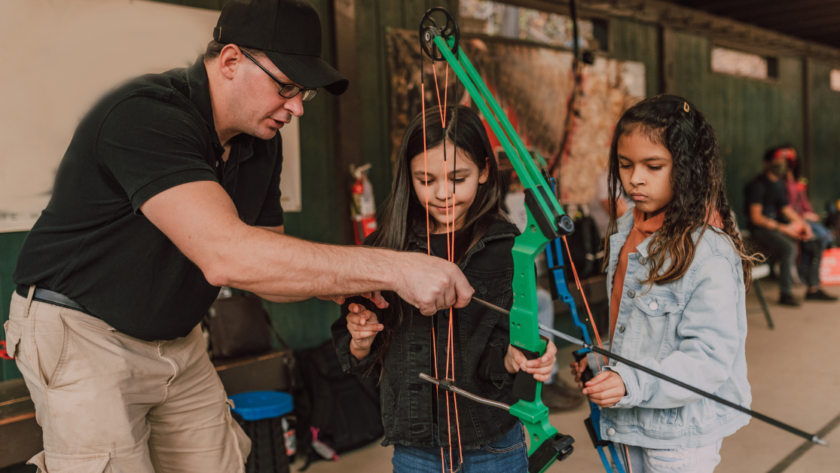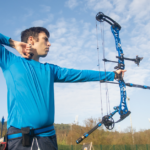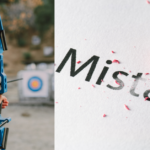As an experienced archer and coach, I’ve seen firsthand how the right practice drills can transform an average shooter into a formidable marksman.
These 12 archery practice drills will help you hone your skills and take your archery to new heights.
The Foundation of Effective Practice
Effective archery practice involves breaking down complex skills into smaller, manageable components and practicing them with full concentration and immediate feedback.
This approach allows you to identify weaknesses and make targeted improvements in your shot sequence, including stance, draw, anchor point, and release.
The 12 Drills That Will Transform Your Archery
1. The Blank Bale Drill
The blank bale drill is a foundational exercise that focuses solely on form and technique. Here’s how to do it:
- Set up a large target butt with no face at about 5-10 yards away.
- Draw your bow and settle into your anchor point.
- Close your eyes to eliminate visual distractions.
- Focus on your body position, back muscle tension, and release smoothness.
- Shoot 20-30 arrows, resetting and refocusing between each shot.
This drill develops muscle memory and helps combat target panic by removing the pressure of hitting a specific point.
2. The 10-Yard Challenge
The 10-yard challenge is all about precision at close range. Here’s how to set it up:
- Place a small target face at just 10 yards.
- Shoot five ends of three arrows each.
- Score your shots and track your progress over time.
- Increase the challenge by using smaller target faces or setting a least score to achieve.
This drill improves your aim, builds confidence, and serves as an excellent warm-up for practice sessions.
3. The One-Arrow Drill
This drill simulates hunting scenarios and teaches patience and focus. Here’s how it works:
- Shoot one arrow.
- Walk to the target to retrieve it.
- Repeat for your entire practice session.
Take your time with each shot, going through your entire pre-shot routine. Analyze your form and the arrow’s impact before retrieving it.
This drill eliminates the tendency to rush or get sloppy that can occur when shooting multiple arrows quickly.
4. The 3-Spot Rotation
The 3-spot rotation improves your ability to adjust your aim quickly and accurately. Here’s how to do it:
- Use a 3-spot target.
- Rotate through each spot with each arrow.
- Start with five ends of three arrows, one in each spot.
- Increase difficulty by using smaller target faces or increasing distance.
Pay attention to how your sight picture changes as you move between spots. Work on making smooth, consistent transitions.
This drill is particularly useful for competitive archers and helps develop mental focus and adaptability.
5. The Pressure Cooker
The pressure cooker drill simulates competition pressure and improves shot efficiency. Here’s how it works:
- Set a timer for two minutes.
- See how many accurate shots you can make in that time frame.
- Start at a comfortable distance with a target size you can consistently hit.
- Increase the challenge by moving back or using smaller targets.
Maintain good form and accuracy while working against the clock. This drill improves your physical speed and enhances your mental game, teaching you to manage time effectively and make quick decisions without sacrificing accuracy.
6. The Blind Bale Drill
The blind bale drill heightens your awareness of body position and shot execution without visual input. Here’s how to do it:
- Set up at about 5 yards from a large target butt.
- Close your eyes from the moment you nock the arrow.
- Go through your entire shot sequence with your eyes closed.
- Open your eyes only after you’ve released the arrow.
- Pay close attention to how your body feels throughout the process.
This drill develops a strong sense of proprioception – your body’s awareness of it’s position in space. It helps identify and correct form issues that you might not notice visually.
7. The Follow-Through Focus
Proper follow-through is crucial for consistent accuracy. Here’s how to practice it:
- After each shot, hold your position for three full seconds before relaxing.
- During those three seconds, pay attention to your bow arm, release hand, and overall body position.
- Check if you’re maintaining a steady stance, if your bow arm is relaxed, and if your release hand is moving straight back.
By focusing on these elements, you’ll develop a more consistent and effective follow-through, leading to tighter groups and improved overall accuracy.
8. The Wind Simulator
Learning to adapt to weather conditions is crucial for outdoor archery. Here’s how to practice shooting in windy conditions:
- Set up a fan to create artificial wind at your practice range.
- Start with a light breeze and gradually increase the intensity.
- Practice shooting at various angles to the wind – headwind, tailwind, and crosswind.
- Pay attention to how the wind affects your arrows and learn to adjust your aim accordingly.
This drill improves your skills in windy conditions and enhances your understanding of arrow flight dynamics.
9. The Distance Ladder
The distance ladder improves your ability to judge distance and adapt your aim accordingly. Here’s how it works:
- Start at 10 yards.
- Move back 5 yards after each successful shot, up to your most effective range.
- If you miss a shot, move forward 5 yards and try again.
- Maintain consistency in your form as the distance increases.
- Pay attention to how your sight picture changes and how you need to adjust your aim.
This drill is particularly useful for field archers and bowhunters who need to be proficient at varying ranges. It builds confidence and improves your ability to estimate distances accurately.
10. The Balloon Pop Challenge
The balloon pop challenge adds an element of instant feedback to your practice. Here’s how to set it up:
- Attach balloons to your target face.
- Challenge yourself to pop them with your arrows.
- Start with larger balloons at a comfortable distance.
- Increase difficulty by using smaller balloons or moving further back.
The satisfying pop of a balloon provides immediate positive reinforcement, which can help combat target panic and build confidence. This drill is also excellent for working on your mental game, as the anticipation of the pop can create a sense of pressure similar to competition or hunting situations.
11. The Endurance Builder
Archery needs both physical and mental stamina. Here’s how to build your endurance:
- Shoot 100 arrows in sets of 10, with short breaks between sets.
- Focus on maintaining good form and consistency during each set.
- Use the breaks to rest, hydrate, and mentally reset.
- Pay attention to how your form and accuracy change as you progress through the drill.
This drill is particularly useful for competitive archers who need to maintain performance over long tournament days. It also helps identify any weaknesses in your form that may become obvious as you fatigue.
12. The Surprise Shot Drill
The surprise shot drill improves your adaptability and mental focus under changing conditions. Here’s how it works:
- Have a training partner call out random commands (e.g., “shoot,” “hold,” “let down”) as you draw your bow.
- Start with simple commands and gradually increase complexity.
- Your partner might call “hold” when you’re at full draw, then “shoot” after a few seconds, or have you let down and immediately draw again.
This drill enhances your ability to maintain focus and good form regardless of external factors. It’s particularly useful for competitive archers and bowhunters who need to be prepared for unexpected situations.
Common Pitfalls and How to Avoid Them
While these drills can significantly improve your archery skills, there are some common pitfalls to be aware of:
Overtraining
Quality is more important than quantity in archery practice. A focused 30-minute session is more useful than a sloppy 2-hour one.
Listen to your body and mind, and don’t push yourself to the point of exhaustion or frustration.
Neglecting Proper Form
Always prioritize good form over speed or quantity. If you find your form deteriorating during a drill, take a break or switch to an easier variation.
Reinforcing poor form through repetition can lead to bad habits that are difficult to break.
Ignoring Mental Preparation
Archery is as much a mental game as it is physical. Incorporate visualization and relaxation techniques into your practice routine.
Before each shot, take a moment to mentally rehearse your perfect form and execution.
Lack of Variety
While consistency is important, doing the same drills in the same order every time can lead to boredom and plateaus. Mix up your routine regularly to keep things fresh and challenging.
Try combining different drills or creating new variations to target specific aspects of your shooting.
Failing to Track Progress
Keep a practice journal to monitor your improvements and identify areas that need more work. Record your scores, notes on form, and any insights or breakthroughs you experience during practice.
This can also help maintain motivation over time as you see tangible evidence of your progress.
Adapting Drills to Different Scenarios
These drills can be adapted to suit various archery disciplines and skill levels:
For Bowhunters
Incorporate 3D targets into your practice and focus more on the one-arrow drill and distance ladder. Practice shooting from different positions (kneeling, seated, etc.) to simulate hunting scenarios.
Use realistic hunting distances and practice in various light conditions.
For Olympic Recurve Archers
Emphasize the pressure cooker and surprise shot drills to prepare for competition scenarios. Practice with a shot clock to simulate tournament conditions.
Focus on maintaining consistent form and execution over long practice sessions to build stamina for multi-day events.
For Traditional Archers
Adapt the blank bale and blind bale drills to work on instinctive shooting skills. Practice at varying distances without changing your aiming method to develop a better feel for arrow trajectory.
Incorporate natural targets (like stumps or leaves) to hone your ability to pick a spot.
Remember, the key is to tailor these drills to your specific goals and needs. Don’t be afraid to experiment and create your own variations based on your strengths and weaknesses.
Building on the Basics
These advanced drills build upon basic archery skills, taking your shooting to the next level. They help refine your technique, improve your mental game, and prepare you for a wide range of shooting scenarios.
As you incorporate these drills into your practice routine, you’ll likely notice improvements in areas such as:
- Consistency in form and execution
- Ability to adapt to different conditions
- Mental focus and resilience
- Physical stamina and endurance
- Overall accuracy and precision
Exercises to Reinforce Learning
To get the most out of these drills, try the following exercises:
Form Analysis
Record video of yourself performing each drill. Review the footage to identify any form issues or inconsistencies.
Pay attention to your stance, draw, anchor point, and release.
Look for any deviations from your ideal form, especially as you fatigue or face challenging situations.
Drill Combination
Create a practice plan that combines multiple drills in a single session. For example, start with the blank bale to warm up and focus on form, move to the 10-yard challenge to work on precision, then finish with the pressure cooker to simulate competition stress.
This approach helps develop well-rounded skills and keeps your practice sessions engaging.
Goal Setting
Set specific, measurable goals for each drill. For instance, aim to increase your score in the 10-yard challenge by 10% over the next month.
Or set a goal to maintain consistent form for 50 consecutive shots during the endurance builder drill.
Having clear goals gives your practice purpose and allows you to track your progress more effectively.
Peer Review
Practice with a partner and provide feedback for each other. Sometimes an outside perspective can spot issues you might miss.
Take turns shooting and observing, focusing on specific aspects of technique.
Discuss what you see and offer constructive suggestions for improvement.
Competition Simulation
Use these drills to create a mock competition scenario. Set up a scoring system, time limits, and even add distractions to mimic real tournament conditions.
This can help you prepare mentally and physically for actual competitions, reducing performance anxiety and improving your ability to focus under pressure.
People Also Asked
What is the best distance for archery practice?
The best distance for archery practice varies depending on your skill level and goals. Beginners often start at 10-20 yards, while experienced archers may practice at 30-50 yards or more.
It’s important to practice at various distances to improve overall proficiency.
How often should I practice archery?
Consistent practice is pivotal in archery. Aim for at least 2-3 sessions per week, each lasting 1-2 hours.
However, quality is more important than quantity, so focus on maintaining good form even during shorter practice sessions.
Can archery be self-taught?
While it’s possible to learn the basics of archery on your own, working with a qualified instructor can help you develop proper form and avoid bad habits. Self-taught archers may struggle to identify and correct their own mistakes.
What muscles does archery work out?
Archery primarily works the muscles in your upper body, including the shoulders, back, chest, and arms. It also engages your core muscles for stability.
Regular practice can improve overall upper body strength and endurance.
Is archery good for mental health?
Archery can have positive effects on mental health. It promotes focus, patience, and stress relief.
The repetitive nature of shooting can be meditative, and achieving goals in archery can boost self-confidence and provide a sense of accomplishment.
How long does it take to become proficient in archery?
The time it takes to become proficient in archery varies greatly depending on natural ability, practice frequency, and quality of instruction. With consistent practice, many archers see significant improvement within 6-12 months, but mastery can take years of dedicated training.
What type of bow is best for beginners?
Recurve bows are often recommended for beginners because of their simplicity and versatility. They’re easier to learn on than compound bows and allow beginners to focus on developing proper form and technique before moving on to more complex equipment.
How do I improve my archery accuracy?
Improving archery accuracy involves consistent practice, focusing on proper form, and developing a repeatable shot process. Utilizing drills like the blank bale and 10-yard challenge can help refine technique and increase precision over time.
What safety precautions should I take when practicing archery?
Always use proper safety equipment, including arm guards and finger tabs. Ensure your practice area is clear of people and obstacles.
Never dry fire a bow (release without an arrow), as this can damage the equipment and potentially cause injury.
Can archery be practiced indoors?
Yes, archery can be practiced indoors with proper equipment and safety measures. Many archery ranges offer indoor facilities, and some archers set up targets in their homes or garages for short-range practice.
Key Takeaways
- Consistent, focused practice is crucial for improving archery skills.
- Isolating specific components of your shot sequence allows for targeted improvement.
- Mental preparation is just as important as physical practice in archery.
- Adapting to various conditions and scenarios enhances overall archery proficiency.
- Regular self-assessment and goal-setting can speed up your progress.



